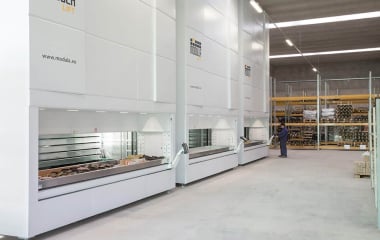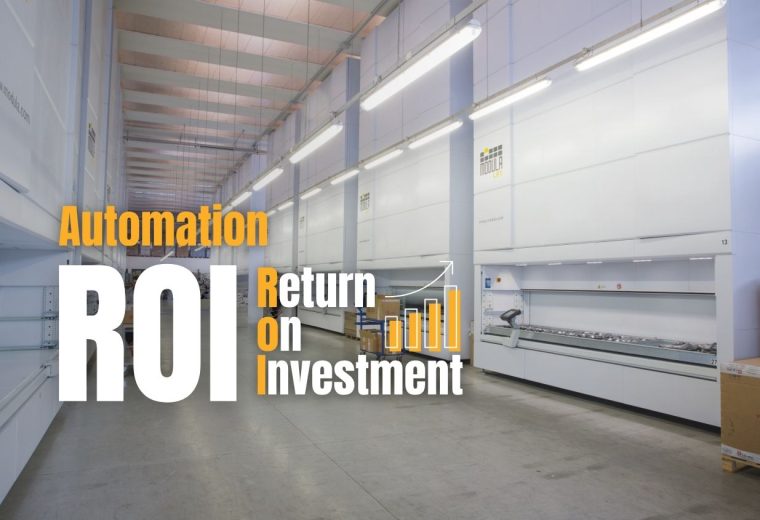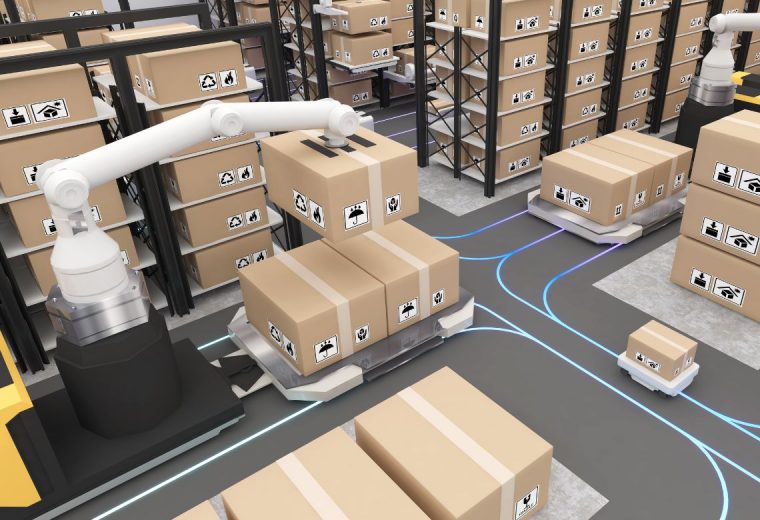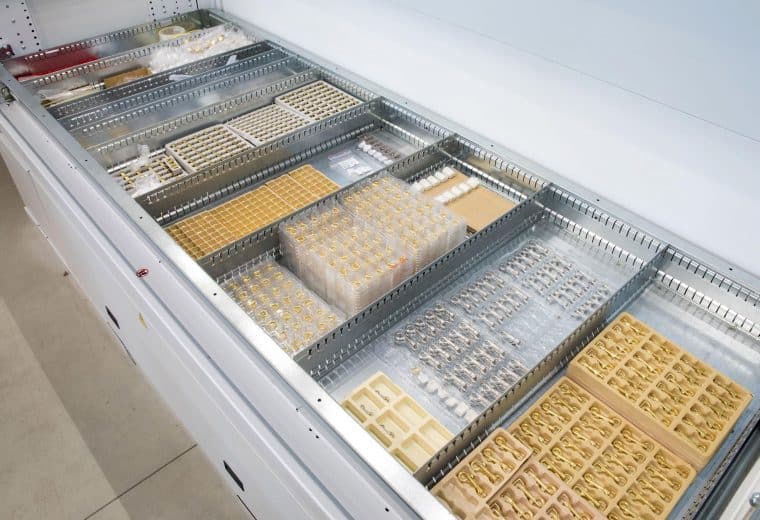Automated Storage and Retrieval Systems [ASRS Meaning + Types]
Automated storage and retrieval systems, also known as ASRS, are extensively utilized in both manufacturing and distribution centers.
They can replace extensive shelving to save floor space, improve employee safety and boost productivity.
Whether you’re wondering how these solutions work or deciding which type of ASRS to invest in, this 101 guide will cover everything you need to know.
We’ll explain its types, benefits and signs that it’s time to make the switch to ASRS. Plus, we’ll introduce you to Modula’s advanced automated solutions which will help you optimize storage, boost efficiency, improve employee safety, and more.
What is an Automated Storage and Retrieval System (ASRS)?
An automated storage and retrieval systems (also known as ASRS or AS/RS) is a robot or computer-controlled technology that can retrieve or store inventory in defined warehouse locations.
ASRS can help you save space, boost picking accuracy, and improve efficiency, among other benefits.
Many ASRS can be integrated with various warehouse software solutions, including warehouse management software (WMS), warehouse execution software (WES) and more, to help you monitor and control your warehouse operations.
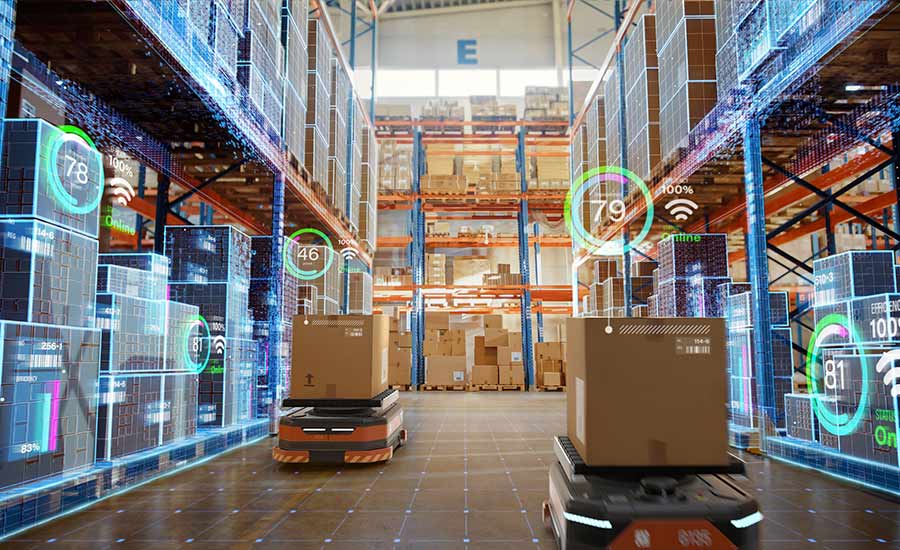
Where to Use Automated Storage and Retrieval Systems
Automated storage and retrieval systems are typically used in manufacturing, warehouses and other distribution areas.
From the automotive and manufacturing industries to retail and pharmaceuticals, ASRS redefine workflow and the use of physical, financial and human resources.
Let’s look at the different ASRS applications:
Point of Use Inventory
An automated storage and retrieval system can help optimize your workflow by safely storing inventory and quickly retrieving it when needed.
Integrating this system with your Warehouse Execution Software (WES) can determine the optimal picking, packing and shipping strategies for each order.
WES considers factors such as inventory levels, order priority, product expiration dates, and shipping requirements.
Goods-to-Person in the Picking and Packing Process
The manual process of walking to storage locations, and picking, packing and processing orders can be time-consuming for warehouse operators. An automated storage and retrieval system eliminates the need for physical movement and reduces the risk of human error.
A shuttle, carousel or crane retrieves the goods you need and delivers them to an assigned workstation.
In addition, ASRS can arrange the items based on size and weight and take the floor plan and shipping zones into account.
Buffer Storage Management
An automated storage and retrieval system can manage buffer stock to nsure you always have an adequate supply of what you need.
In addition, ASRS help you reduce travel time and ensure your buffer stock is secure from potential employee theft.
Order fulfillment
Consumers worldwide shop around the clock while expecting timely delivery.
An automated storage and retrieval system can help you streamline your warehouse operations by retrieving ordered goods and holding them in buffer storage, when orders are waiting to be shipped.
9 Types of Automated Storage and Retrieval Systems
There are nine main types of automated storage and retrieval systems that you can utilize within your warehouse:
Unit-Load ASRS
Unit-Load ASRS store and retrieve bulky and heavy loads, including pallets and cases.
The weight they can handle ranges from 1,100 to 5,500 pounds (500 to 2,500 kg), while they have the ability to reach up to 100 feet.
The structure of the unit-load ASRS includes a pallet rack with narrow aisles where cranes can travel and move the pallets according to your instructions.
You can use unit-load ASRS in high-density areas with bulky loads to safely store inventory and retrieve items quickly with minimal labor.
There are two types of unit-load ASRS: fixed-aisle and moveable aisle cranes.
- A fixed-aisle unit-load ASRS is a system that moves pallet racks in between narrow aisles. Whether moving vertically and horizontally, a fixed crane travels between the aisles to retrieve and store inventory.
- A moveable aisle crane unit-load ASRS functions in a similar way, but the crane is not fixed and it uses a track to move between the aisles. This type of unit-load ASRS is suitable for larger facilities with more space.
Mini-Load ASRS
Mini-load ASRS, also known as tote-stacking and case-handling ASRS, differ from unit-load systems in terms of the weight they can handle, which is typically around 77 pounds (35 kg).
You can use a mini-load automated storage and retrieval system to store and retrieve cartons, trays, or totes in small-space facilities with many stock keeping units (SKUs).
They are also a great solution if you need to buffer and release products to picking and packing stations.
Robotic Shuttle-based ASRS
Shuttle-based ASRS use a robotic shuttle to deliver items without the need for human intervention.
The shuttle is powered by a battery or a capacitator. It can work on a single level or multiple levels, using a track to move between racks and transport goods to the assigned workstations.
Robotic-shuttle based ASRS travel at high speeds, with a throughput range between 200 and 700 lines per hour. This type of ASRS can handle totes, trays and cases that weigh from anywhere between 35 to 100 pounds.
Robotic Cube-based Storage
Robotic cube-based storage is an automated storage and retrieval system that utilizes a three-dimensional grid of cubes to store and retrieve items.
Inventory is stored in bins that are stacked on top of each other inside a cube. Smart robots are then placed on top of the cubes to retrieve bins and transport them to a workstation.
Floor Robots
Floor robots, also known as automated guided vehicle (AGVs) or autonomous mobile robots (AMRs), transport inventory within your warehouse to improve efficiency and reduce travel time for employees.
These vehicles are guided by magnetic strips, wires or sensors and travel along pre-defined routes set by warehouse operators.
On the other hand, autonomous mobile robots are more sophisticated robots that are equipped with artificial intelligence, machine learning and sensors to help them travel in the warehouse without human intervention.
You can utilize floor robots to transport bins, boxes and smaller inventory, such as small parts.
Check out Modula’s autonomous mobile robots in action:
Modula & MiR: automatic storage systems and autonomous mobile robots. How do they work together?
Horizontal Carousel-based ASRS
A horizontal carousel-based ASRS consists of a track with rotating bins. The bins contain inventory that is ready to store, retrieve and transport to assigned locations.
Once you request an item, the ASRS automatically delivers the product to you, with an indicator showing the carousel and shelf where it is located.
Horizontal carousels are the ideal solution for high-speed picking in a low ceiling environment.
In either a production or distribution setting, the horizontal carousel helps save space, reduce labor costs, boost throughput and accuracy and manage inventory.
Check out Modula’s horizontal carousel in action:
Modula HC for the US Market: the New Horizontal Carousel for Efficient Picking
Vertical Carousel-based ASRS
Vertical carousel-based ASRS consist of carriers that rotate vertically and deliver stored goods to the operator at an ergonomic height.
They are primarily used to store small parts or documents.
Vertical Lift Module ASRS
Vertical lift module ASRS are made of an inserter/extractor and a tray column arranged in an enclosed system. They are the ideal solution if you are looking for a goods-to-person ASRS.
Upon your request, the inserter/extractor device finds and retrieves the tray where the item is located and delivers it to your warehouse operator.
Vertical lift module ASRS allow you to store inventory regardless of shape, weight and size.
Check out Modula’s vertical lift in action:
Modula Lift: the vertical storage system
Micro-Load Stocker
If you are working in a high-density warehouse and you need an ASRS for buffering, sequencing and point-of-use goods, a micro-load stocker is the perfect fit.
A micro-load stocker consists of a series of robots running across a dense storage grid to store and pick inventory bins and deliver them to a conveyor or workstation.
There are different systems of micro-load stockers available on the market and they are typically integrated with other automated storage and retrieval systems.
Benefits of Automated Storage and Retrieval Systems
From managing inventory to boosting workplace safety, automated storage and retrieval systems can help you:
- Make use of existing vertical and horizontal space
- Boost efficiency
- Improve employee safety
- Increase productivity
- Improve picking accuracy
- Optimize inventory control
- Speeds up order fulfillment, from receiving to shipping
- Reduce labor costs
- Reduce rental costs for extra warehouse space by taking advantage of smaller spaces

8 Signs That You Need Automated Storage and Retrieval Systems
Still uncertain if an ASRS is the right fit for your warehouse operations? Here are some signs that it’s time to consider this innovation.
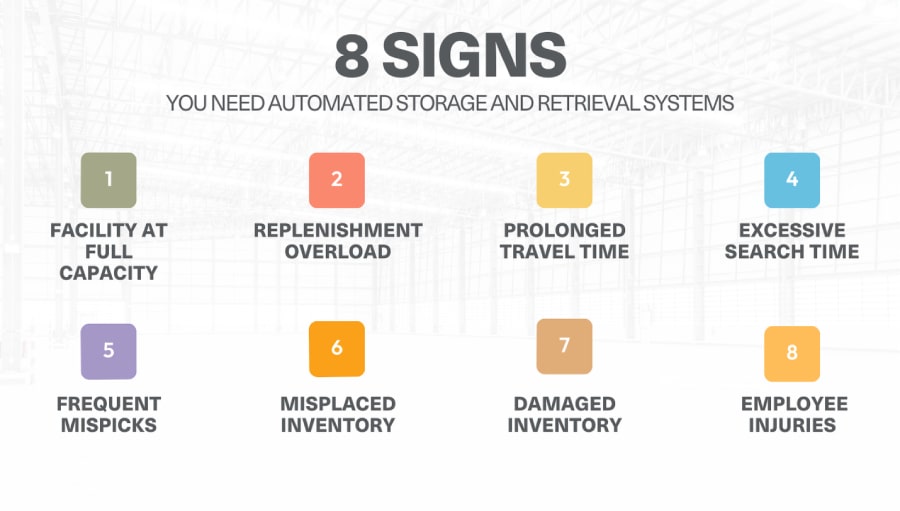
- Facility at full capacity: When your warehouse has reached its limit, ASRS can help optimize your space by maximizing your vertical height and reducing aisle widths.
- Replenishment overload: When manual replenishment tasks take up too much time and resources, automation can help streamline these processes.
- Prolonged travel time: If your warehouse operators take too long to travel from point A to point B within the warehouse, ASRS can help optimize the movement of goods by automating retrieval and storage processes.
- Excessive search time: Visually searching for inventory items is inefficient and prone to errors. ASRS can help by automating the inventory management process, enabling quick and accurate item retrieval using precise location tracking and real-time inventory updates.
- Mispicks: Frequent picking errors can harm your business’s reputation and financial performance. ASRS can help reduce these errors by employing the goods-to-picker principle, automatically bringing items to the operator.
- Misplaced inventory: If your warehouse employees frequently misplace goods, it can disrupt operations and cause inaccuracies. ASRS can help by organizing and accurately tracking inventory, ensuring each item is stored and retrieved from its designated location.
- Damaged inventory: Product damage often stems from disorganization or incorrect storage. ASRS can help lower the risk of damage by offering automated, controlled storage solutions, including options for climate control or clean environments.
- Risk of employee injury: Worker safety is crucial in the warehouse, where manual handling tasks are a leading cause of common injuries. ASRS can help minimize the risk of employee injuries by automating repetitive tasks and fostering ergonomics in the workplace, such as reducing the need for bending, lifting and walking long distances.

How to Choose the Right ASRS for Your Warehouse
Here are some factors to consider when choosing the right ASRS for your warehouse:
Warehouse Size and Layout
Evaluate your warehouse’s physical dimensions and overall layout. An ASRS needs to fit into your existing space with minimal disruption and should enhance flow rather than create bottlenecks.
To determine the type of ASRS your operations will need, consider your facility’s ceiling height, aisle width and floor load capacity.
For example, if your warehouse has minimal floor space but has high vertical clearance, consider investing in a vertical lift module (VLM).
Inventory Type
Analyze the type of inventory your warehouse stores, as different ASRSs are better suited for various SKUs.
For example, if your inventory requires specific climate conditions — such as perishable materials, electronics, or medical equipment — consider using temperature-controlled vertical modules to maintain the integrity and longevity of your stored goods.
Integration with Other Warehouse Systems
Select an ASRS that integrates seamlessly with your existing warehouse management system (WMS) and other technology to ensure inventory accuracy and real-time data exchange.
Opt for systems that synchronize real-time data to guarantee that stock levels, order status and other critical data points are updated consistently across all platforms.
Additionally, consider whether the ASRS provider you’ll partner with offers compatibility with your current setups or if upgrades will be necessary.
Maintenance Requirements
Consider the long-term maintenance needs of the ASRS you choose, as some systems require more frequent upkeep.
For example, vertical carousel storage systems may require routine software updates, hardware checks and parts replacements, which only qualified technicians can perform.
What Is the Price Range for Automated Storage and Retrieval Systems?
The cost of automated storage and retrieval systems varies widely.
For example, a vertical carousel can cost between $60,000 and $80,000, while an extensive mini-load or cubic ASRS system that handles tens of thousands of SKUs can cost more than $500,000.
Several factors can influence the cost of an ASRS system, including:
- The ASRS module
- The amount of storage space needed
- The size and weight of the inventory being handled
- The complexity of the software and machine controls
- The cost of customizing and retrofitting the equipment and facility
- Special storage or handling requirement, such as temperature-controlled units
- Shipping, delivery and installation expenses of the unit
- Integration with existing warehouse systems, such as WMS, DMS and ERP
Modula’s Automated Storage and Retrieval Systems
At Modula, we redefine your warehouse operations to ensure space optimization, improved accuracy and efficiency and increased safety, among other benefits.
Our automated storage and retrieval systems include:
Modula Vertical Lift Modules
If your warehouse has high ceilings and you are looking to utilize your existing space, we recommend our Modula vertical lift modules.
You can store large inventories securely and access your items at any time with a single click on the Copilot controller. Fast, accurate and safe, this simple process eliminates the possibility of errors and boosts productivity.
Choose from two VLMs:
- Modula Lift: Convenient for heavy loads and quick picking times, Modula Lift is the ideal storage solution for industrial products, components and spare parts for all possible environments and industries.
- Modula Slim: With twice the load capacity of typical vertical carousels in a small footprint of only 32.29 square feet (3 square meters), Modula Slim can change your working environment and improve your storage and retrieval process.
Modula Horizontal Carousels
If the ceiling in your warehouse or storage area is low, consider our Modula horizontal carousel.
With a picking accuracy of up to 99% and picking rates of up to 550 lines per hour for each employee, this solution will allow you to use every inch of your space while improving productivity and reducing the risk of hazards.
Boasting compactness and flexibility, Modula horizontal carousels fit perfectly in areas of complex geometry or architectural complexities.
From taking advantage of existing space to increasing productivity and beyond, automated storage and retrieval systems can improve organization, accuracy and productivity in your warehouse.
At Modula, you can select a vertical or horizontal ASRS in line with your space specifications, business needs and goals. Our solutions are safe, efficient and designed to streamline your warehouse operations.



